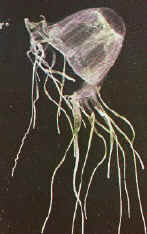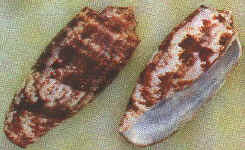

![]()
Swimming
The
golden rule with regard to surfing is, "Bathe between the Flags". There are many patrolled beaches in Australia and these have an area of the beach marked by flags. This area is relatively safe and is watched by life savers in case a swimmer gets into difficulty. Other areas on the beach or on unpatrolled beaches may have dangerous rips. A rip is a current or an under tow, which carries the water which has been brought to the beach by wave action, back out again. The strength of a rip depends on the formation of the beach, but they are sometimes so strong that even the strongest swimmer would have difficulty swimming against them. If you must swim on an unpatrolled beach, ask locals about conditions, or at least be very aware of a current sweeping you sideways along the beach. Somewhere it may meet an opposing current and turn rapidly out to sea!Box Jellyfish or Sea Wasp
 While on the subject of swimming, most people now
know that in the warmer part of the year when the ocean is so inviting, there are
dangerous jelly fish in the northern waters. The Box Jellyfish, or Sea Wasp, is a
said to be the most venomous marine animal known. This and many other dangerous
animals are described in detail in Dr. Carl Edmond's extremely good reference book, "Dangerous
Marine Creatures" ISBN 0 941 332-39 X. I highly
recommend this book to any one diving in Australian waters. It could save you a lot
of pain or even your life! Not only does Dr. Edmonds describe the animals and their
dangers, but he also gives first aid procedures for helpers and full medical advice for a
doctor treating the injury. If you must swim in dangerous waters, wear a full wet suit or
protective clothing.
While on the subject of swimming, most people now
know that in the warmer part of the year when the ocean is so inviting, there are
dangerous jelly fish in the northern waters. The Box Jellyfish, or Sea Wasp, is a
said to be the most venomous marine animal known. This and many other dangerous
animals are described in detail in Dr. Carl Edmond's extremely good reference book, "Dangerous
Marine Creatures" ISBN 0 941 332-39 X. I highly
recommend this book to any one diving in Australian waters. It could save you a lot
of pain or even your life! Not only does Dr. Edmonds describe the animals and their
dangers, but he also gives first aid procedures for helpers and full medical advice for a
doctor treating the injury. If you must swim in dangerous waters, wear a full wet suit or
protective clothing.
Further info: http://en.wikipedia.org/wiki/Chironex_fleckeri
Blue Ringed Octopus
The blue ringed octopus is resident on beaches all
around Australia, but quite common around Sydney. It sometimes is left stranded in tidal
rock pools when the tide goes down. If an unknowing person happens to wade through the
rock pool and stand on it with bare feet, it will naturally bite. The bite is not very
painful, but it can cause death by suffocation in less than five minutes.
The poison acts on the nervous system and causes cramps in various muscles including those
of the lungs so that one dies from suffocation. Don’t walk through rock pools.
Smaller octopuses sometimes hide in discarded sea shells, so be careful handling seemingly
dead shells.
Further info on Wikipedia: http://en.wikipedia.org/wiki/Blue-ringed_octopus
Typical Cone Shell, Conus geographus
 The cone shell, as the name
indicates, is an attractive cone shaped shell found around shallow waters, reef, ponds and
rubble. A proboscis protrudes from the narrow end of the shell, but can normally reach the
full length of the shell. Holding it by the thick end is not safe. A small extremely
poisonous harpoon is shot from the proboscis and is capable of penetrating clothing. About
25% of cone shell stings
result in death. I knew a large man in New Guinea who almost died from the sting of a
seemingly dead cone shell that he had picked up on the beach an put in his pocket.
The cone shell, as the name
indicates, is an attractive cone shaped shell found around shallow waters, reef, ponds and
rubble. A proboscis protrudes from the narrow end of the shell, but can normally reach the
full length of the shell. Holding it by the thick end is not safe. A small extremely
poisonous harpoon is shot from the proboscis and is capable of penetrating clothing. About
25% of cone shell stings
result in death. I knew a large man in New Guinea who almost died from the sting of a
seemingly dead cone shell that he had picked up on the beach an put in his pocket.
Further info on Wikipedia: http://en.wikipedia.org/wiki/Conus_geographus
Stone Fish
Link to further info: http://www.qm.qld.gov.au/Find+out+about/Animals+of+Queensland/Fishes/Venomous+fishes/Stonefish#.UsFhPClbBjo
Funnelweb Spider
There are about 40 species of
funnel-web spiders but the Sydney funnel-web is the best known, as Sydney was built right
on it's habitat and so it gets to bite more people. They can be deadly, so if you are
camping in the bush always check your shoes before you put them on and be careful if
gathering firewood etc. They live in burrows in the ground which are lined with spider web
thus giving the effect of a funnel. Some species live in trees and make their home in
cracks in the bark etc. There is now an antivenene for the poison, but you first have to
get to a hospital.
Wikipedia: http://en.wikipedia.org/wiki/Sydney_funnel-web_spider
Red Backed Spider
The red back spider can also give a very painful
bite. It is common throughout the northern areas and has a striking
black body about the size of a small pea with a brilliant red diamond on it. It tends to
hide under wood or rubbish lying on the ground and can be aggressive when protecting its
egg sack.
Wikipedia: http://en.wikipedia.org/wiki/Redback_spider
Summary:
If you take care you should be ok. Wear good shoes and long trousers when bush walking and be careful, particularly when collecting firewood. Never step over a log on the ground without first looking to see what is on the other side, it could be a snake! When wading in shallow water, watch where you walk and be careful what you pick up along the shore.
Good Luck, Kerry Cassidy
![]()